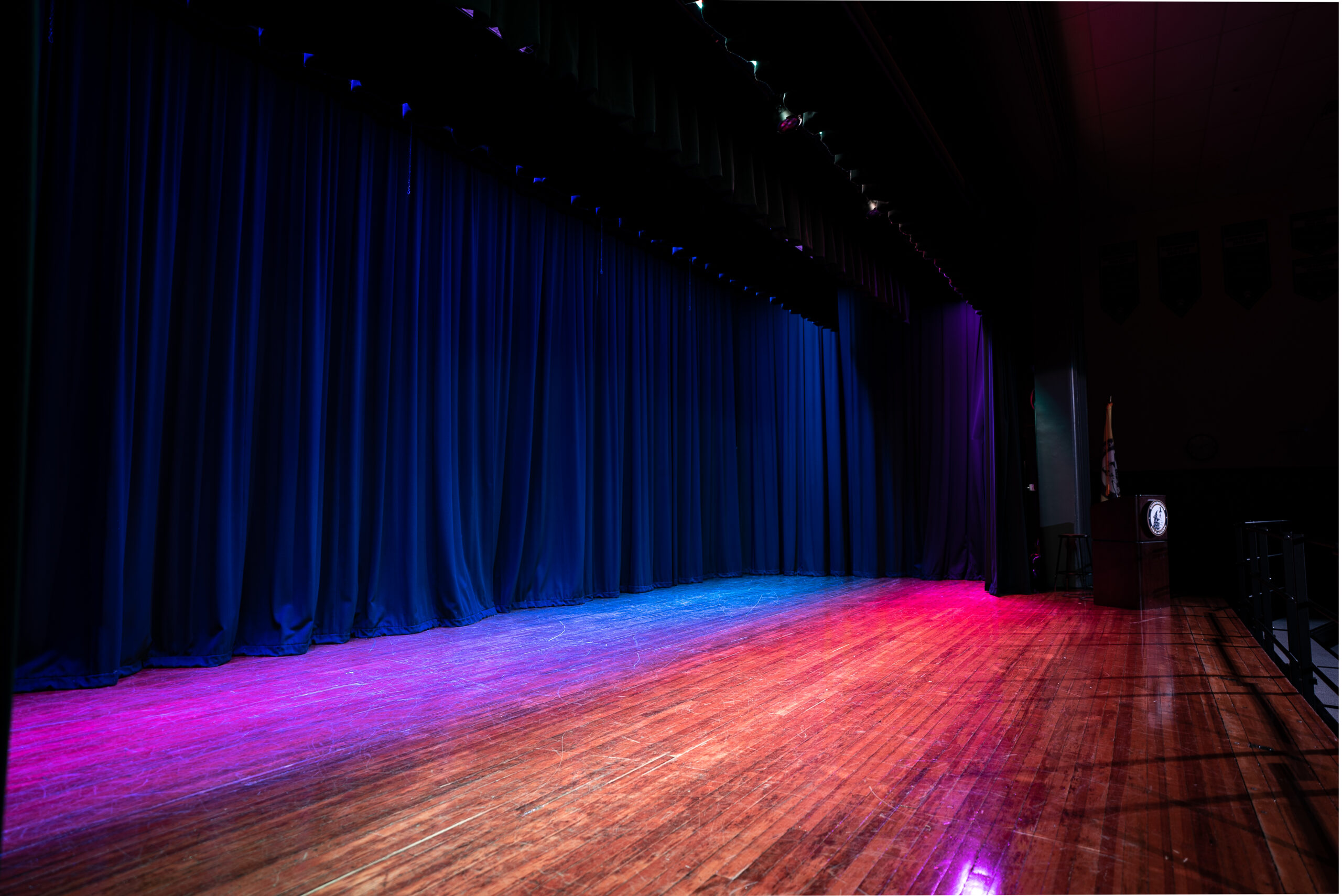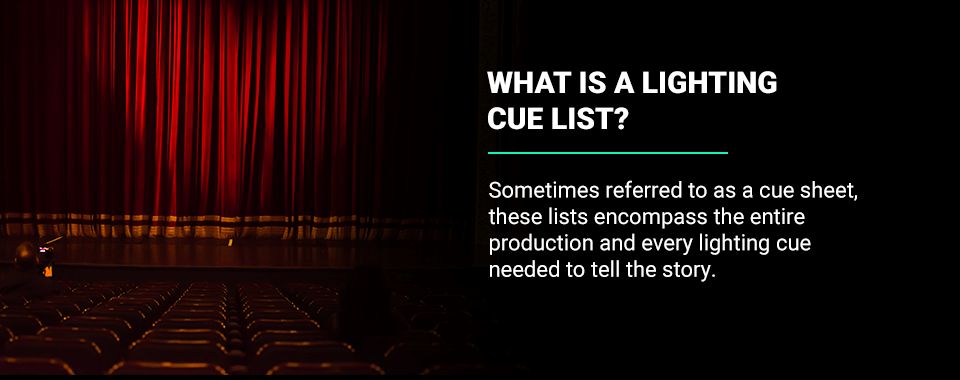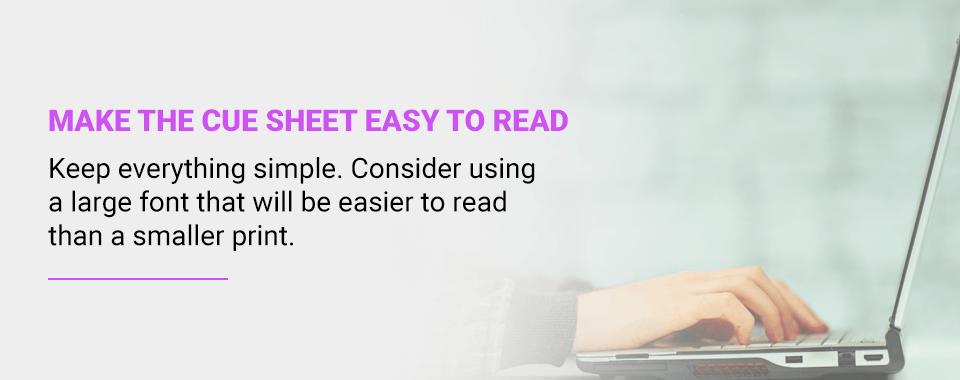

Lighting plays a vital role in any live performance. Whether your stage is hosting a stand-up comedy night or the local community theater is putting on a rendition of a Shakespeare play, lighting enhances the audience’s experience. It guides viewers to where they should be paying attention, and it provides an important part of the ambiance for the show.
With proper lights and lighting cues, theaters of all sizes can put on a performance worth raving about. But before the show can go on, a stage manager or lighting technician should understand theatrical cues and how to create and follow a lighting cue list.
A lighting cue is a visual indicator to the performers that a specific action is supposed to happen at a precise time. During a stage performance, actors rely on prompts to hit their marks and keep the show running smoothly.
Typically, a lighting technician or the show’s stage manager will take control of the lighting cues. They are responsible for either programming or triggering the cue, depending on the theater’s available technology.
In recent years, advancing technology has changed theater in many ways. Technicians can now program lighting cues ahead of time. Using devices like monitors and headsets gives stage managers additional control and involvement in the show. Cues have never been more technologically integrated into a theater’s setup.
Some lighting cues are simple with a flashing white light. Others use traffic light colors to indicate various alerts to the performers. Red is often a warning cue. Yellow signifies that the actors should be on standby. And green typically means that it is go-time.
Lighting cues are predetermined and rarely modified during the actual performance of a show. They keep the actors on pace and signify where the production is at for everyone behind the scenes.

In short, a lighting cue list is the full collection of a production’s lighting cues. Sometimes referred to as a cue sheet, these lists encompass the entire production and every lighting cue needed to tell the story. Each sheet includes concise notes specifying the details of each cue. Most lists include the following:
The more specific the cue list is, the more the lighting technician will understand when and where the cue should occur.
Again, advancements in lighting technology have changed how theaters work with their cue lists and how technicians play each cue.
Some lighting consoles allow technicians to program all of the cues before the performance. Other setups require a stage manager to trigger each cue manually.
Depending on the size of a theater and the technology available to the production, cue sheets can be more or less complex. The number of cues included on a show’s cue list can vary from as few as 50 to as many as hundreds for prestigious performances.
Once you understand how lighting technicians and stage managers use a lighting cue sheet during a performance, you can begin creating a sheet of your own.
Use these tips to make the best lighting cue sheet for your next show.
If you want to learn how to write lighting cues, you can start with spreadsheet software and the performance script. Using a new spreadsheet, create five columns and include the following:
Once you have all of the information relating to the cues recorded in this spreadsheet, you will be ready to test them out and make necessary changes to enhance the show.

When putting together a lighting cue sheet, it is best to make the text as easy to read as possible — things can get hectic on performance night. Whoever is in charge of the lighting will want a straightforward sheet to follow along with. There is no need for glitzy or overly customized cue sheets.
Instead, keep everything simple. Consider using a large font that will be easier to read than a smaller print. Technicians must be able to easily see what cue is coming up next, even in low lighting
Using a sans serif font can help create an easily scannable cue sheet, too. You’ll also want to opt for black text on white paper to make the text pop.
In addition to keeping the fonts and colors simple, you will want to keep any written directions noted as straightforward as possible. Write out any cue notes using clear language so that you or any other person in charge of lighting can quickly read what they need to do.
With any live stage performance, there can be a lot of hectic commotion behind the scenes. Between pre-performance jitters and the overall sense of excitement, important things can get mixed up.
In show business, it is always best to come prepared. Having backup copies of any lighting cue sheets you have created is a great tip for being prepared no matter what the night brings, whether people are absent or running late.
Lighting effects can make a performance look and feel more professional. Knowing what timing is important in stage lighting cues helps the production create the right mood and effect. The following are fundamental times for a lighting cue:
Before running through your cues during a practice performance, testing them in order and with no timing can be helpful. Each programmed cue will fire off after the other, and you can see how each one influences the next.
You can observe how the lighting fixtures behave and if they interfere with the next effect. For instance, one cue may make a light turn sideways when it needs to be upright for the following action. You can address and make adjustments for rough changes so that the performance can go on without a hitch.

Another tip for getting the lighting right is to know the production’s story. Understanding how the plot unfolds and frequently referencing the script can create better lighting cues to complement the narrative.
Remember that the person in charge of lighting is also responsible for enhancing a performance’s storytelling. Whether it is the death of an important character or a chilling monologue, knowing the story allows you to make the best lighting decisions to move the audience. Focus on every detail in the script and create effects that heighten the experience for everyone on and off stage.
Before landing on a production’s lighting cue timing, you might want to conduct some research. Watching other productions, whether they are in person or online, can give you great insights into the best lighting practices. It can be especially helpful to watch other theaters’ performances of the show you are working on.
Whether you are a stage manager or lighting technician, you could benefit from studying other plays and performances. Compare well-funded productions with smaller, community theater versions. Bigger productions may inspire you with high-tech lighting gadgets, while community theaters could exhibit creativity and resourcefulness that you could use in your own show.
When it comes to finding the perfect lighting cue timing, your theater’s current AVL setup could be holding you back. Consider upgrading your lighting with help from our team of AVL experts at Illuminated Integration.
We work with your theater to design a lighting arrangement that illuminates your stage and complements every performance. We believe in customized, one-of-a-kind solutions that cater to your specific facility. Lighting technology is always evolving, and introducing new fixtures into your space can enhance your stage performances and cue timing.
Our experts can help teach your team everything they need to know about lighting, from color to movement, and give your theater the tools to create the most effective timing and display.
If you are interested in improving your theater’s performance lighting, there are a few steps you will need to take. Here are six tips to enhance the effects of any production.
Before putting together lighting cues for a new play, you should paint a picture of what you want for each scene. Ask yourself the following questions:
Use your answers to find the right lighting solutions to create the most impactful visual for the audience.
When getting your lighting cues together for a new performance, you should check out what technology is available to you. Whether your school or theater has a full lighting grid or something a little more simple, there are ways of making the most of either option. You only need to know which one you have at your fingertips. Sometimes, it is necessary to rent or upgrade your lighting fixtures to meet your goals.
When creating the lighting cue list for a live show, it is important to reference the script often. Lighting effects are best when they adhere to the details of the performance. Keeping the script close as you create your list allows you to hit every mark necessary for a seamless show. Be sure to include cues for the following:
Don’t forget to get the stage manager a copy of the script with lighting cues included.
For theaters with the technology to program their lighting cues beforehand, programming effects that recur at the same time can save you a few minutes.
For example, maybe your performance has multiple scenes that take place in a nighttime setting. You can program that darker setting once and make a note of repeated cue numbers for the lighting technician or stage manager responsible for plugging them into the lighting console.
One way to improve performance lighting is making notes for how long each cue should last — there is a surprising difference between a three-second fade and a six-second fade! Your lighting technician will have a much better understanding of how each cue should look and feel. Keeping track of the exact duration of each cue will allow technicians to follow the flow of the performance and impress the audience.
Performance lighting can be pretty technical. A simple way of improving stage lighting is differentiating between the following on stage:
These three settings differentiated early on in the performance’s preparation will help keep everyone on stage safer and changing scenes will run more smoothly.
Having great stage lighting can enhance any performance and leave the audience mesmerized. Proper lighting cues also allow the performers to hit every mark seamlessly. When a theater takes its lighting seriously, it permeates through every show.
Our team of AVL experts at Illuminated Integration can design a lighting arrangement specifically for your venue and goals. Whether you want to do a total upgrade to your setup or swap your current bulbs for LED options, we can create a custom design for your theater or auditorium.
Interested in learning more about improving stage lighting? Contact Illuminated Integration today!